Wenchi Cheng
Towards Reliable Emergency Wireless Communications over SAGINs: A Composite Fading and QoS-Centric Perspective
Oct 08, 2025Abstract:In emergency wireless communications (EWC) scenarios, ensuring reliable, flexible, and high-rate transmission while simultaneously maintaining seamless coverage and rapid response capabilities presents a critical technical challenge. To this end, satellite-aerial-ground integrated network (SAGIN) has emerged as a promising solution due to its comprehensive three-dimensional coverage and capability to meet stringent, multi-faceted quality-of-service (QoS) requirements. Nevertheless, most existing studies either neglected the inherent characteristics of the complex channel conditions due to the terrain changes or analyzed the performance in the absence of QoS constraints, resulting in a mismatch between theoretical analysis and practical performance. To remedy such deficiencies, in this paper we establish a performance modeling framework for SAGIN employing the Fisher-Snedecor $\mathcal{F}$ composite fading model to characterize the air-ground link. In specific, the proposed $\mathcal{F}$ composite fading channel is adopted to accurately describe both multipath fading and shadowing in harsh ground environments. The exact distribution of end-to-end signal-to-noise (SNR) statistics for space-air and air-ground links is developed, enabling theoretical analysis of cascaded channels with fixed-gain amplify-and-forward (AF) and decode-and-forward (DF) relaying protocols, respectively. Furthermore, asymptotic expressions of the derived results are provided to offer concise representations and demonstrate close alignment with theoretical predictions in the high-SNR regime. Finally, the insightful closed-form and asymptotic expressions of effective capacity with QoS provisioning, outage probability, and $\epsilon$-outage capacity are investigated, respectively, followed by both field measurements and Monte Carlo simulations to verify the effectiveness.
Joint Transmit and Receive Beamforming for Tri-directional Coil-Based Magnetic Induction Communications
May 30, 2025Abstract:In this paper, we enhance the omnidirectional coverage performance of tri-directional coil-based magnetic induction communication (TC-MIC) and reduce the pathloss with a joint transmit and receive magnetic beamforming method. An iterative optimization algorithm incorporating the transmit current vector and receive weight matrix is developed to minimize the pathloss under constant transmit power constraints. We formulate the mathematical models for the mutual inductance of tri-directional coils, receive power, and pathloss. The optimization problem is decomposed into Rayleigh quotient extremum optimization for transmit currents and Cauchy-Schwarz inequality-constrained optimization for receive weights, with an alternating iterative algorithm to approach the global optimum. Numerical results demonstrate that the proposed algorithm converges within an average of 13.6 iterations, achieving up to 54% pathloss reduction compared with equal power allocation schemes. The joint optimization approach exhibits superior angular robustness, maintaining pathloss fluctuation smaller than 2 dB, and reducing fluctuation of pathloss by approximately 45% compared with single-parameter optimization methods.
Joint Topology and Power Optimization for Multi-UAV Collaborative Secure Communication
Apr 23, 2025Abstract:In this paper, we investigate an unmanned aerial vehicle (UAV)-enabled secure communication scenario that a cluster of UAVs performs a virtual non-uniform linear array (NULA) to communicate with a base station (BS) in the presence of eavesdroppers (Eves). Our goal is to design the UAV topology, trajectory, and precoding to maximize the system channel capacity. To this end, we convert the original problem into equivalent two-stage problems. Specifically, we first try to maximize the channel gain by meticulously designing the UAV topology. We then study the joint optimization of the trajectory and precoding for total transmit power minimization while satisfying the constraints on providing quality of service (QoS) assurance to the BS, the leakage tolerance to Eves, the per-UAV transmit power, the initial/final locations, and the cylindrical no-fly zones. For the UAV topology design, we prove that the topology follows the Fekete-point distribution. The design of trajectory and precoding is formulated as a non-convex optimization problem which is generally intractable. Subsequently, the non-convex constraints are converted into convex terms, and a double-loop search algorithm is proposed to solve the transmit power minimization problem. Introduce random rotation offsets so as to perform a dynamic stochastic channel to enhance the security. Numerical results demonstrate the superiority of the proposed method in promoting capacity.
Emergency Communication: OTFS-Based Semantic Transmission with Diffusion Noise Suppression
Apr 10, 2025Abstract:Due to their flexibility and dynamic coverage capabilities, Unmanned Aerial Vehicles (UAVs) have emerged as vital platforms for emergency communication in disaster-stricken areas. However, the complex channel conditions in high-speed mobile scenarios significantly impact the reliability and efficiency of traditional communication systems. This paper presents an intelligent emergency communication framework that integrates Orthogonal Time Frequency Space (OTFS) modulation, semantic communication, and a diffusion-based denoising module to address these challenges. OTFS ensures robust communication under dynamic channel conditions due to its superior anti-fading characteristics and adaptability to rapidly changing environments. Semantic communication further enhances transmission efficiency by focusing on key information extraction and reducing data redundancy. Moreover, a diffusion-based channel denoising module is proposed to leverage the gradual noise reduction process and statistical noise modeling, optimizing the accuracy of semantic information recovery. Experimental results demonstrate that the proposed solution significantly improves link stability and transmission performance in high-mobility UAV scenarios, achieving at least a 3dB SNR gain over existing methods.
Continuous-Aperture Array Based OAM High-Capacity Communication For Metaverse
Feb 12, 2025
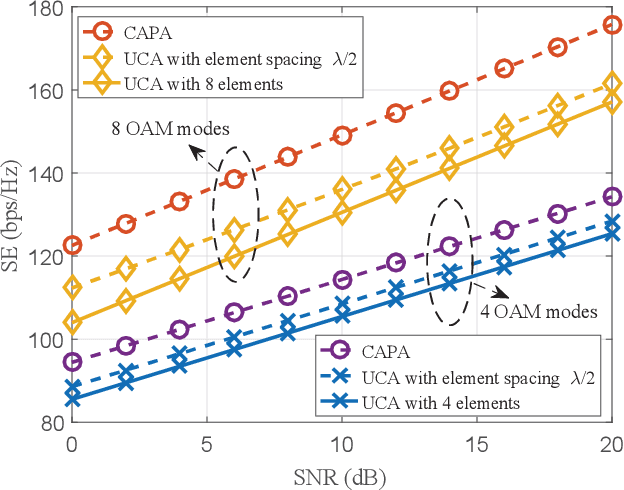
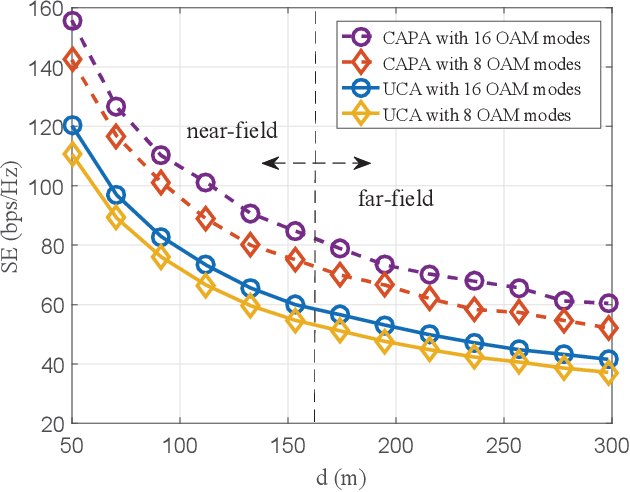
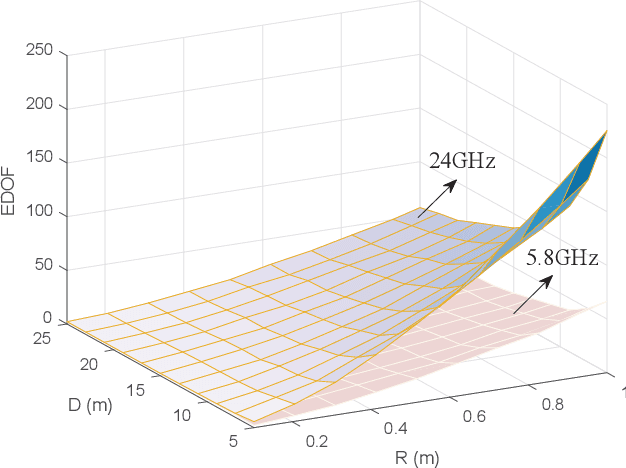
Abstract:The extensive data interaction demands of an immersive metaverse necessitate the adoption of emerging technologies to enable high-capacity communication. Vortex electromagnetic waves with different orbital angular momentum (OAM) modes are spatially orthogonal, providing a novel spatial multiplexing dimension to achieve high-capacity communication. However, the number of orthogonal OAM modes based on a discrete uniform circular array (UCA) is limited by the number of array elements in the UCA, and traditional discrete channel models are unable to accurately capture the physical properties of vortex electromagnetic wave propagation. The continuous-aperture array (CAPA) is composed of densely packed electromagnetic excitation elements, capable of flexibly and efficiently generating the desired surface currents to produce an arbitrary number of mutually orthogonal OAM modes. From the perspective of electromagnetic information theory (EIT), we propose a CAPA-based OAM orthogonal transmission scheme to realize high-capacity communication. We design the surface currents of the CAPA using Fourier basis functions, derive the electromagnetic channel for vortex electromagnetic waves, and investigate the upper bound of the spectrum efficiency for CAPA-based OAM orthogonal transmission. This paper establishes a theoretical foundation for applying EIT to the orthogonal transmission of vortex electromagnetic waves, offering a novel solution for achieving CAPA-based efficient and high-capacity communication.
Digital-Analog Transmission based Emergency Semantic Communications
Jan 03, 2025



Abstract:Emergency Wireless Communication (EWC) networks adopt the User Datagram Protocol (UDP) to transmit scene images in real time for quickly assessing the extent of the damage. However, existing UDP-based EWC exhibits suboptimal performance under poor channel conditions since UDP lacks an Automatic Repeat reQuest (ARQ) mechanism. In addition, future EWC systems must not only enhance human decisionmaking during emergency response operations but also support Artificial Intelligence (AI)-driven approaches to improve rescue efficiency. The Deep Learning-based Semantic Communication (DL-based SemCom) emerges as a robust, efficient, and taskoriented transmission scheme, suitable for deployment in UDP based EWC. Due to the constraints in hardware capabilities and transmission resources, the EWC transmitter is unable to integrate sufficiently powerful NN model, thereby failing to achieve ideal performance under EWC scene. For EWC scene, we propose a performance-constrained semantic coding model, which considers the effects of the semantic noise and the channel noise. Then, we derive Cramer-Rao lower bound of the proposed semantic coding model, as guidance for the design of semantic codec to enhance its adaptability to semantic noise as well as channel noise. To further improve the system performance, we propose Digital-Analog transmission based Emergency Semantic Communication (DAESemCom) framework, which integrates the analog DL-based semantic coding and the digital Distributed Source Coding (DSC) schemes to leverage their respective advantages. The simulation results show that the proposed DA-ESemCom framework outperforms the classical Separated Source-Channel Coding (SSCC) and other DL-based Joint Source-Channel Coding (DL-based JSCC) schemes in terms of fidelity and detection performances.
Capacity Analysis on OAM-Based Wireless Communications: An Electromagnetic Information Theory Perspective
Dec 16, 2024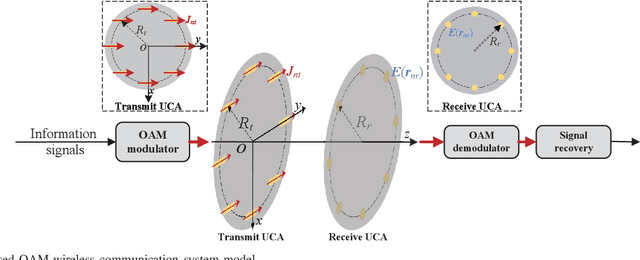
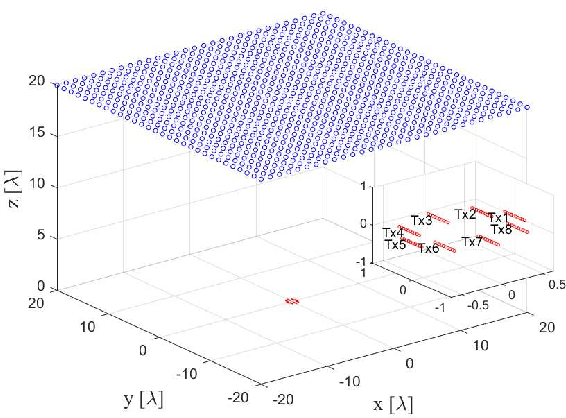
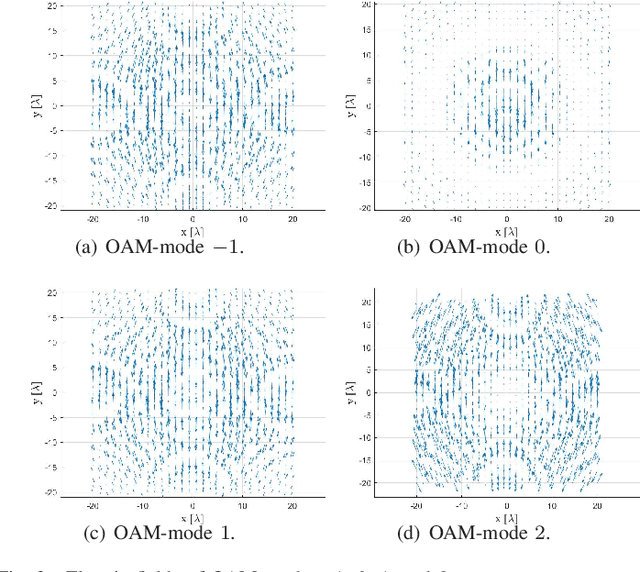
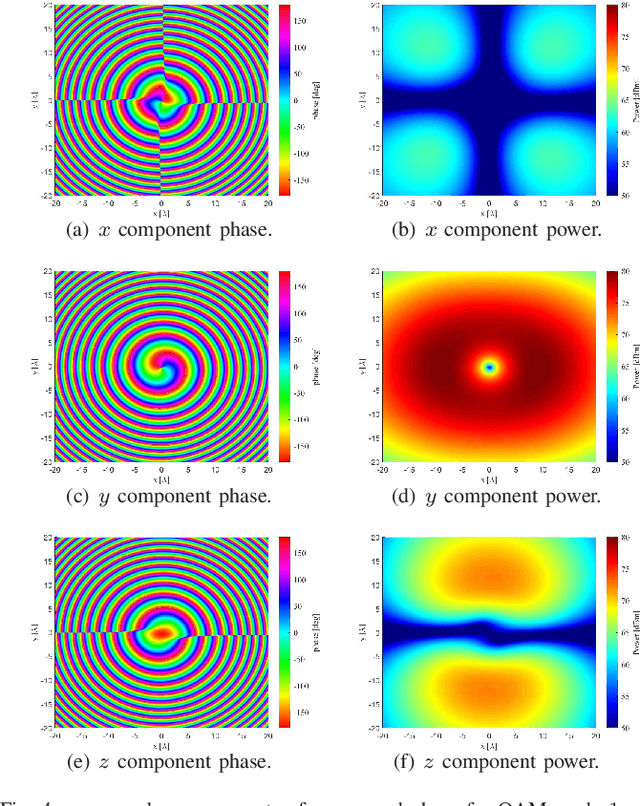
Abstract:Orbital angular momentum (OAM) technology enhances the spectrum and energy efficiency of wireless communications by enabling multiplexing over different OAM modes. However, classical information theory, which relies on scalar models and far-field approximations, cannot fully capture the unique characteristics of OAM-based systems, such as their complex electromagnetic field distributions and near-field behaviors. To address these limitations, this paper analyzes OAM-based wireless communications from an electromagnetic information theory (EIT) perspective, integrating electromagnetic theory with classical information theory. EIT accounts for the physical properties of electromagnetic waves, offering advantages such as improved signal manipulation and better performance in real-world conditions. Given these benefits, EIT is more suitable for analyzing OAM-based wireless communication systems. Presenting a typical OAM model utilizing uniform circular arrays (UCAs), this paper derives the channel capacity based on the induced electric fields by using Green's function. Numerical and simulation results validate the channel capacity enhancement via exploration under EIT framework. Additionally, this paper evaluates the impact of various parameters on the channel capacity. These findings provide new insights for understanding and optimizing OAM-based wireless communications systems.
MAC Revivo: Artificial Intelligence Paves the Way
Oct 21, 2024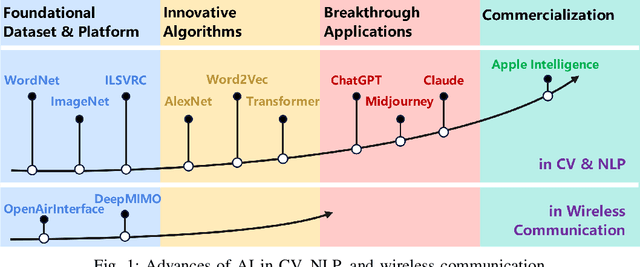
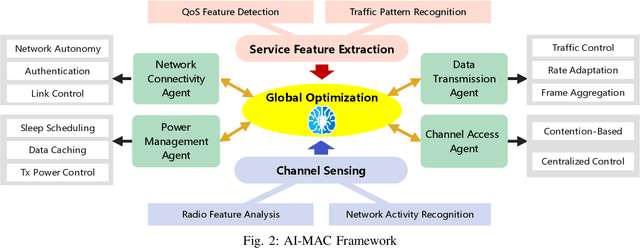
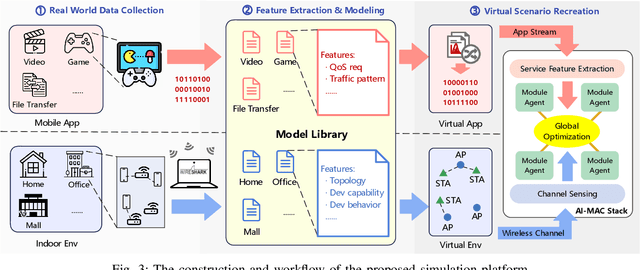
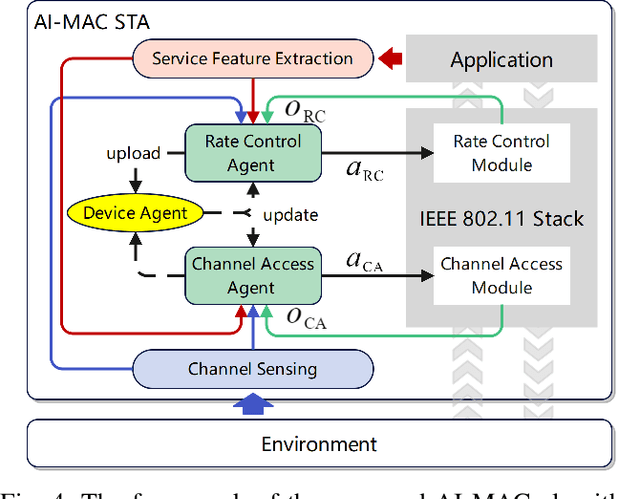
Abstract:The vast adoption of Wi-Fi and/or Bluetooth capabilities in Internet of Things (IoT) devices, along with the rapid growth of deployed smart devices, has caused significant interference and congestion in the industrial, scientific, and medical (ISM) bands. Traditional Wi-Fi Medium Access Control (MAC) design faces significant challenges in managing increasingly complex wireless environments while ensuring network Quality of Service (QoS) performance. This paper explores the potential integration of advanced Artificial Intelligence (AI) methods into the design of Wi-Fi MAC protocols. We propose AI-MAC, an innovative approach that employs machine learning algorithms to dynamically adapt to changing network conditions, optimize channel access, mitigate interference, and ensure deterministic latency. By intelligently predicting and managing interference, AI-MAC aims to provide a robust solution for next generation of Wi-Fi networks, enabling seamless connectivity and enhanced QoS. Our experimental results demonstrate that AI-MAC significantly reduces both interference and latency, paving the way for more reliable and efficient wireless communications in the increasingly crowded ISM band.
SC-CDM: Enhancing Quality of Image Semantic Communication with a Compact Diffusion Model
Oct 03, 2024



Abstract:Semantic Communication (SC) is an emerging technology that has attracted much attention in the sixth-generation (6G) mobile communication systems. However, few literature has fully considered the perceptual quality of the reconstructed image. To solve this problem, we propose a generative SC for wireless image transmission (denoted as SC-CDM). This approach leverages compact diffusion models to improve the fidelity and semantic accuracy of the images reconstructed after transmission, ensuring that the essential content is preserved even in bandwidth-constrained environments. Specifically, we aim to redesign the swin Transformer as a new backbone for efficient semantic feature extraction and compression. Next, the receiver integrates the slim prior and image reconstruction networks. Compared to traditional Diffusion Models (DMs), it leverages DMs' robust distribution mapping capability to generate a compact condition vector, guiding image recovery, thus enhancing the perceptual details of the reconstructed images. Finally, a series of evaluation and ablation studies are conducted to validate the effectiveness and robustness of the proposed algorithm and further increase the Peak Signal-to-Noise Ratio (PSNR) by over 17% on top of CNN-based DeepJSCC.
SAFE: Semantic Adaptive Feature Extraction with Rate Control for 6G Wireless Communications
Oct 02, 2024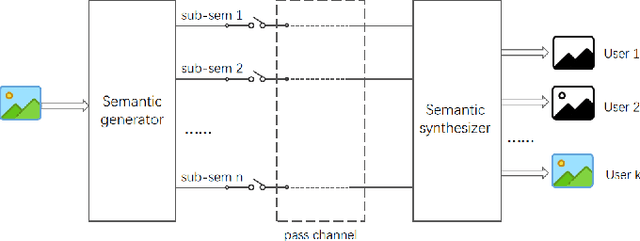
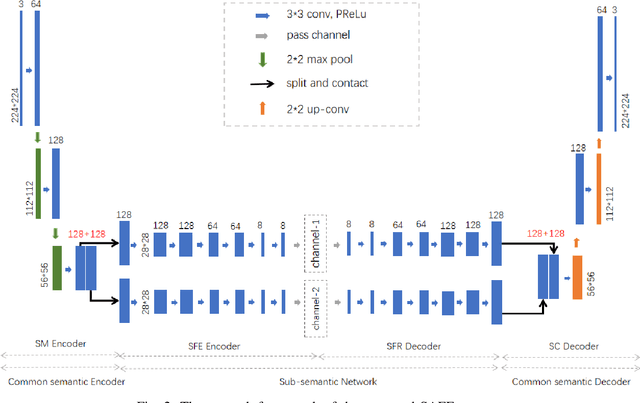
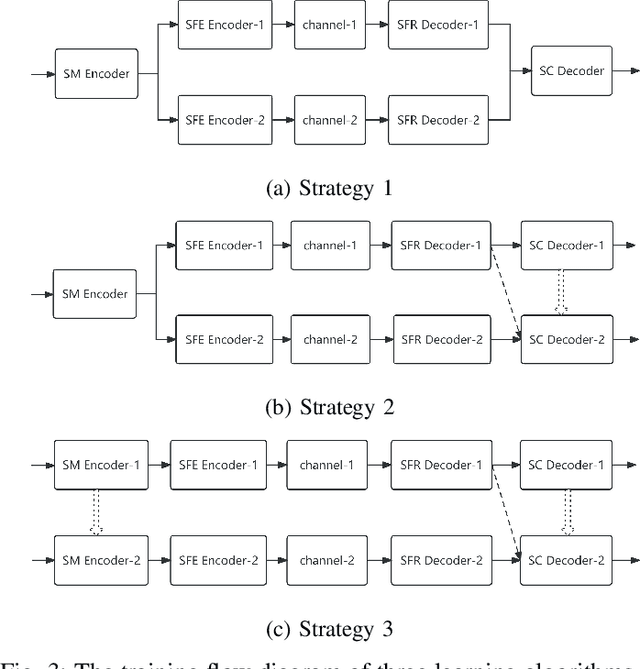
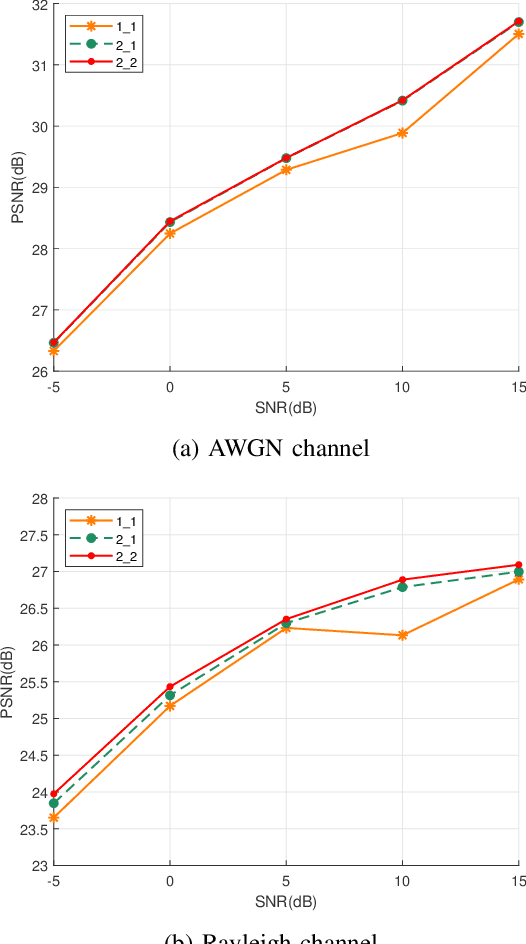
Abstract:Most current Deep Learning-based Semantic Communication (DeepSC) systems are designed and trained exclusively for particular single-channel conditions, which restricts their adaptability and overall bandwidth utilization. To address this, we propose an innovative Semantic Adaptive Feature Extraction (SAFE) framework, which significantly improves bandwidth efficiency by allowing users to select different sub-semantic combinations based on their channel conditions. This paper also introduces three advanced learning algorithms to optimize the performance of SAFE framework as a whole. Through a series of simulation experiments, we demonstrate that the SAFE framework can effectively and adaptively extract and transmit semantics under different channel bandwidth conditions, of which effectiveness is verified through objective and subjective quality evaluations.
 Add to Chrome
Add to Chrome Add to Firefox
Add to Firefox Add to Edge
Add to Edge